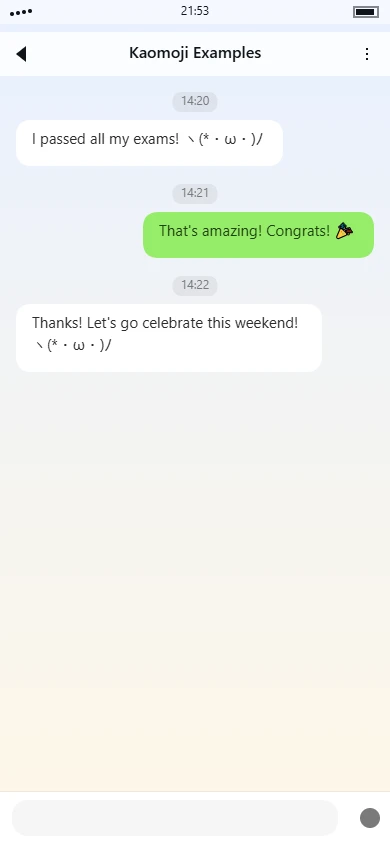(─‿‿─) kaomoji meaning | usage tips

Overview
The kaomoji (─‿‿─) presents a stylized facial expression composed entirely of ASCII characters, creating a distinctive visual representation of contentment. The overall structure uses parentheses as the face outline, with two sets of curved lines forming the eyes and a central character creating the mouth area. This arrangement produces a balanced, symmetrical appearance that conveys a specific emotional tone through its character composition and spacing.
Symbol Breakdown
- Parentheses as face outline: The opening and closing parentheses
and(
create a rounded container that suggests the shape of a face, providing a clear boundary for the expression) - Horizontal bars for closed eyes: The two
characters positioned at the top represent eyes that are gently closed or squinting, suggesting a relaxed, contented state rather than wide-eyed excitement─ - Double curved mouths as cheeks: The
symbols serve dual purpose as both smiling mouth elements and cheek indicators, with their upward curve reinforcing the positive emotional expression‿ - Symmetrical spacing: The equal distribution of characters creates visual balance, with the eyes and mouth elements evenly spaced within the facial outline
Emotion & Aesthetic Analysis
This kaomoji conveys a sense of quiet satisfaction or gentle happiness rather than exuberant joy. The closed eyes suggest contentment, peacefulness, or mild amusement, making it suitable for situations where someone is pleased but not overly excited. The double curved symbols in the mouth area create a subtle smiling effect that appears more restrained than kaomoji with wide-open grins or toothy smiles.
Compared to similar kaomoji like (^‿^) or (◕‿◕), this version has a more subdued quality due to the horizontal eye characters. The horizontal bars for eyes create a squinting effect that suggests the character is experiencing a pleasant moment without needing to visually engage with the surroundings. This makes it particularly effective for expressing quiet satisfaction, gentle agreement, or peaceful contentment in digital communication.
The character composition follows a minimalist approach, using only five distinct elements to create a complete facial expression. Each character serves a clear visual purpose without decorative additions, resulting in a clean, easily recognizable expression that works well across different platforms and font renderings. The overall effect is one of understated positivity that can convey agreement, mild happiness, or peaceful acceptance without overwhelming emotional intensity.
Tag categories
Use tags to quickly understand this kaomoji.
Usage guide
Usage Guide for (─‿‿─)
The kaomoji (─‿‿─) is a charming and versatile facial expression that conveys a sense of playful contentment, gentle mischief, and quiet satisfaction. With its closed eyes and subtle smile, this emoticon radiates a warm, approachable vibe that's perfect for casual online communication. It captures that feeling when you're secretly pleased about something, sharing a private joke, or simply enjoying a moment of peaceful happiness. The expression sits somewhere between a knowing smirk and a contented grin, making it ideal for situations where you want to show you're in on the fun without being overly exuberant.
This kaomoji works particularly well in text-based conversations where tone can be difficult to convey. It adds personality to your messages while maintaining a lighthearted, friendly atmosphere. You'll often see it used among friends, in gaming communities, and on social media platforms where users appreciate its understated charm. The closed eyes suggest a sense of comfort and relaxation, while the curved mouth indicates genuine pleasure, creating a balanced expression that's neither too intense nor too casual.
Common Use Cases
- Responding to a friend's funny story in a group chat
- Expressing quiet satisfaction after solving a tricky problem
- Reacting to cute animal photos or heartwarming content
- Acknowledging a clever pun or witty remark
- Showing you're enjoying a casual game session with friends
- Responding to good news with gentle enthusiasm
- Expressing that you're comfortably settled in for a relaxing evening
- Reacting to food pictures that look particularly delicious
- Showing appreciation for a thoughtful gesture
- Expressing quiet confidence about a personal achievement
- Reacting to nostalgic memories shared by friends
- Showing you're content with how a situation turned out
Example Conversations
-
Friend A: Just finished all my assignments for the week! Friend B: Nice! Time to relax now (─‿‿─)
-
Gaming buddy: Managed to beat that boss on the first try You: Knew you had it in you (─‿‿─)
-
Family member: Made your favorite cookies, they're in the kitchen You: You're the best! (─‿‿─) heading there now
-
Colleague: The meeting got moved to next week You: Perfect timing (─‿‿─) gives me more prep time
-
Online friend: Remember that show we used to watch as kids? You: Those were good times (─‿‿─)
-
Group chat member: sends a hilarious meme You: This is too accurate (─‿‿─)
Important Notes
While (─‿‿─) is generally well-received, it's important to consider your audience and context before using it.
- Avoid using this kaomoji in formal or professional communications such as business emails, official reports, or serious work discussions. The playful nature might come across as unprofessional in these settings.
- Be mindful that the closed eyes can sometimes be interpreted as smug or self-satisfied depending on the context. If you're discussing sensitive topics, consider using a more straightforward expression.
- This emoticon works best in established relationships where the tone is understood. With new acquaintances, it might be better to use more explicit expressions until you're comfortable with each other's communication styles.
- The expression carries different weight across platforms - on Discord and gaming communities it's very common, while in more formal social networks it might stand out more. Adjust usage based on platform norms.
- Remember that cultural interpretations can vary. While generally positive in Western contexts, the meaning might shift slightly in different cultural settings, so observe how others use similar expressions in your specific online communities.
Usage examples
Real conversation samples that feature this kaomoji.

Example 1

Example 2
Related kaomoji
You might also enjoy these kaomoji.